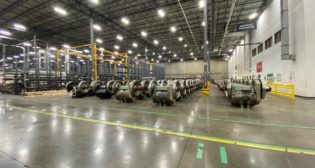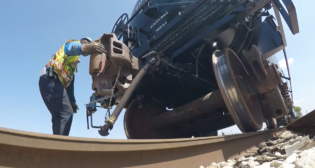
Analyzing “fail to couple” yard events
Written by William C. Vantuono, Editor-in-ChiefIn mid-2011, CSX conducted a study within the classification yard at its Selkirk Yard in New York State. A record of events described as “failures-to-couple” (FTC) were documented. FTC events, including events related to a car stalling on the tracks, were counted. Over three 8-hour sessions, 10.5% of all cars humped resulted in a FTC event. Of the 10.5% of cars, 3.3% of all cars humped resulted in a FTC event due to a stalled car. Based on estimates from this study, FTC event related delays are a problem the railroads spend several millions of dollars each year to manage.
Under the direction of the Association of American Railroads’ Strategic Research Initiatives Program, Transportation Technology Center, Inc. (TTCI), in conjunction with CSX Transportation and International Electronic Machines Corporation, designed a test program to determine the root causes for cars failing to couple in hump yards. The Precision Test Track at the Transportation Technology Center, Pueblo, Colo., was used to create impacts between railcars over a range of operating speeds. In addition to impact speed changes, the coupler lateral position relative to the draft gear pocket and the amount the knuckle was open on the incoming car were also altered. Data collection was done using a series of high-speed cameras. This gave the researchers opportunities to see frame by frame how each event caused the couplers or knuckles to move.
Results from the test program indicate that one of the major contributors to FTC events is the lateral coupler position of the incoming car. When the coupler of the incoming car is shifted to the right, there is a lower probability of successful couplings. The only exception to this observation is when both couplers of the incoming and receiving cars are shifted to the right.
Knuckle position of the incoming car also proved to be a critical variable in FTC events. Results indicate that as the knuckle of the incoming car is more open, the potential for coupling increases significantly. When the coupler of the incoming car is shifted to the right, it is unlikely that the cars will couple correctly.
Impact speed was not as big a factor, as initially hypothesized. During the test program, coupling was influenced more by coupler position and knuckle position then speed. Visual inspections of components between impacts showed that higher speed impacts caused an increased amount of wear and damage. This damage contributed to several broken components, including cracked striker plates, broken brake hose castings, broken uncoupling levers, and a cracked coupler.
The objective of this test program is to broaden the understanding of the industry by studying coupling events and FTC events from vantage points that were previously inaccessible. By examining the interaction of the components in both proper coupling events and FTC events, differences can be explored that may lead to strategies to reduce the number of FTC events and broken components in the future. This testing has shown that in some cases the positions of coupling components may be very similar but result in different outcomes. An event like this is summarized in Technology Digest TD-12-014 titled “Investigation of ‘Fail to Couple’ Events in Hump Yards.”
Additional testing conducted in 2012 focused on the positions of the knuckles and couplers and less on the speed. Data from these tests will be published in future TTCI Technology Digests.



